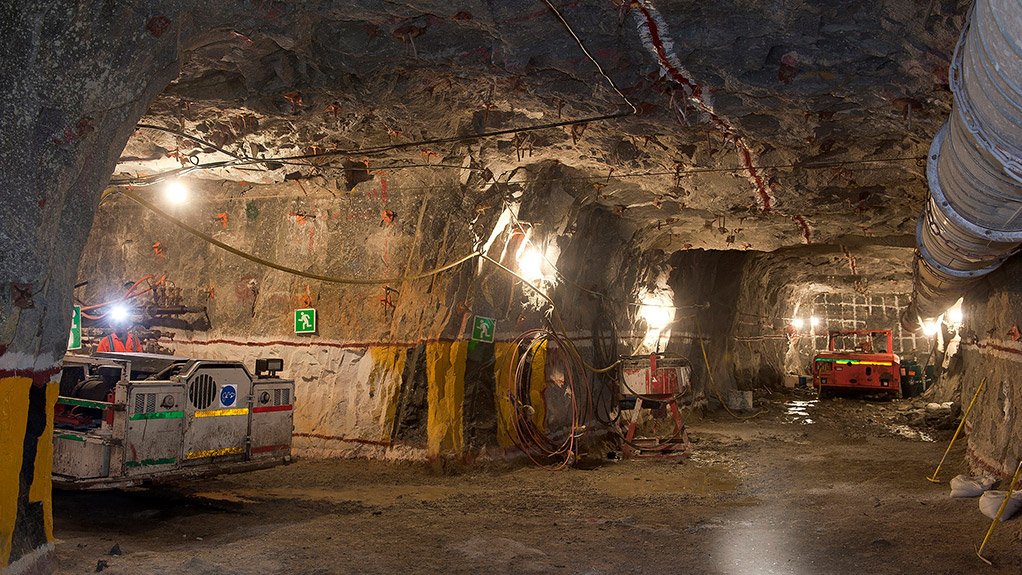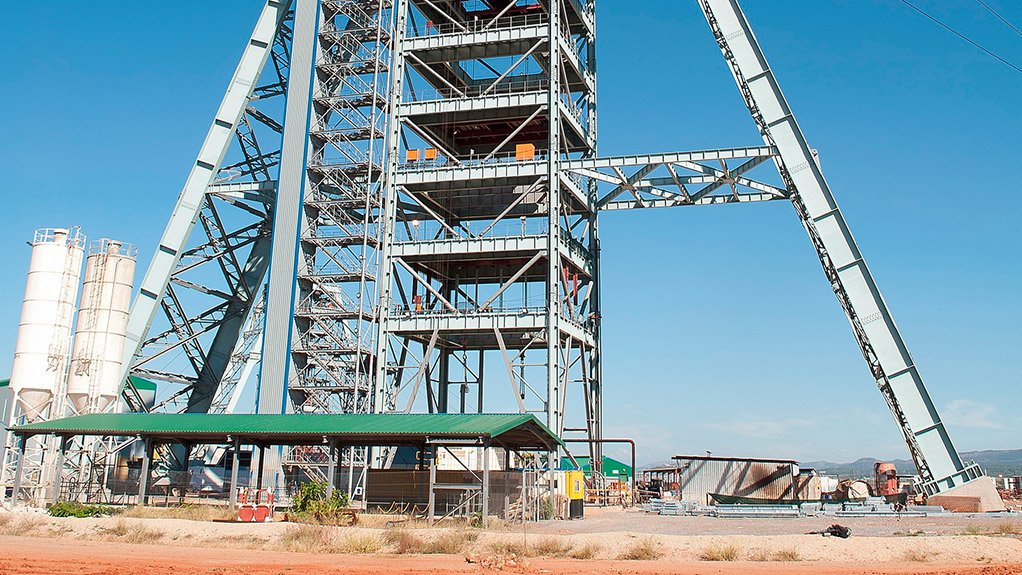WorleyParsons on track at Bakubung
This article has been supplied as a media statement and is not written by Creamer Media. It may be available only for a limited time on this website.
Four years since the production phase kicked off at Wesizwe Platinum’s Bakubung mine near Rustenburg, contractors WorleyParsons have reported good progress, with the project set to deliver first ore from the Merensky reef by the end of 2017. According to Ryan Illingworth, WorleyParsons RSA’s senior project manager on the Wesizwe Underground Project, work completed includes the main terrace comprising the production shaft headgear, and the sinking of both the production and services shafts.
“The vital work of equipping the production shaft is now about halfway, with steelwork successfully and safely installed so that the rock skips and man-cages can be installed early in 2017,” said Illingworth. “This puts us on track to commission the ore-handling system in mid-2017.”
WorleyParsons have been involved at Bakubung mine – previously the Frischgewaagd-Ledig project – for almost a decade, having contributed at pre-feasibility and feasibility stages of the project’s inception. In 2012 they were appointed as the engineering, procurement, construction management (EPCM) contractor.
Optimised and ahead of schedule
With main commissioning of the mine scheduled for the fourth quarter of 2018, production will gradually ramp up to a steady-state level of 260,000 tonnes per month in 2021; this date is a remarkable two years earlier than originally planned.
“The time-saving was achieved by optimising our design and shortening the shaft depths,” according to Morne Pelser, Wesizwe projects and controls manager. “Access ways to the reef were re-designed, and the loading box was raised to 77 Level – taking some 200 metres off the depth of the shafts.” The loading box, a key item of underground infrastructure, comprises a conveying system that discharges ore into a flask, which in turn discharges into skips.
“The optimisation has brought about savings in both time and cost, allowing us to look forward to intersect reef by end-2017,” said Pelser.
Critical path development
For now, the focus is on critical path development underground – currently underway to connect the two shafts at each of the four levels. “Each of the levels – 69 Level, 72 Level, 77 Level and 81 Level – have so far been opened up and we are now working on the flat development before we can go out to reef,” said Illingworth. “That includes ore-passes, refuge chambers on each level and electrical infrastructure to power the equipment on each level.”
One temporary ore-pass has so far been commissioned from 77 to 81 Level, with another nearing completion from 72 to 81 Level; later this year will see an extension to the latter ore-pass, from 69 to 72 Level.
“This will allow us to transfer rock from each of the levels down to the bottom level so it can be hoisted out through the service shaft,” he said. “Two fleets of trackless equipment are currently in operation – one on 77 Level and another on 81 Level.”
Rolling out contracts
Contracts have recently been placed for the sewage plant, which will service the entire mine and the housing village, as well as the buildings and facilities for the control room. Road-building, construction of parking areas, and security access building contracts are also underway. The order for Wesizwe’s first fleet of trackless equipment has been placed; this includes two Sandvik drill rigs and a separate order for load-haul-dumpers (LHDs), whose delivery is expected in October. This will be the first equipment to be owned and managed by the mine.
“Flat development was split into a ‘yellow phase’ and a ‘red phase’,” said Illingworth. “The slower, higher-cost-per-ton development characterises the yellow phase, in which rock is hoisted from the service shaft in 10-ton kibbles. This phase ends with the commissioning of the ground-handling system, when the red phase can begin to speed up development through the use of skips to remove rock quicker and more cost-efficiently.”
For the yellow development phase, the contractor supplied their own equipment, while the mine provides the equipment during the red phase. “This is part of the process of the owner becoming operationally prepared to eventually take over the mining activities,” he said. “The red phase – the second phase of the project – is essentially capital footprint development to ready the operation for full-scale mining.”
Supporting local
Pelser highlighted Wesizwe’s commitment to supporting local suppliers and service providers. “The work has been parcelled out to local contractors in accordance with the project’s Social and Labour Plan,” he said, “so we are confident that the project is having the desired positive impact on the local economy – as intended by the Department of Mineral Resources’ regulations and requirements.” He said Wesizwe is meeting its targets on all levels – if not exceeding them.
“We are very pleased with progress to date, and we go the extra mile with our smaller contractors, by developing their capacity to meet our standards and to become sustainable players in the industry,” said Pelser. Bakubung is expected to mine for 30 years, and will employ over 3,100 people when full production is reached.
Optimising expenditure
Another aspect of the optimisation was to defer some aspects of surface infrastructure to between 2018 and 2020, although WorleyParsons have already completed the engineering on these. “Taking into account the difficult economic environment, certain non-critical items – such as office space and change-houses that would not immediately be required – were identified for later development,” said Illingworth. “These packages could be deferred without delaying the project, to preserve capital expenditure.”
Over the past year, WorleyParsons have been phasing out of its construction management role into a brief duration of construction supervision. “Wesizwe is gradually taking over this activity in a planned process, and will assume all construction supervision from October 2016,” he said. “Our role will then focus on engineering, with some support in certain project areas such as control planning and contract administration.”
Comments
Press Office
Announcements
What's On
Subscribe to improve your user experience...
Option 1 (equivalent of R125 a month):
Receive a weekly copy of Creamer Media's Engineering News & Mining Weekly magazine
(print copy for those in South Africa and e-magazine for those outside of South Africa)
Receive daily email newsletters
Access to full search results
Access archive of magazine back copies
Access to Projects in Progress
Access to ONE Research Report of your choice in PDF format
Option 2 (equivalent of R375 a month):
All benefits from Option 1
PLUS
Access to Creamer Media's Research Channel Africa for ALL Research Reports, in PDF format, on various industrial and mining sectors
including Electricity; Water; Energy Transition; Hydrogen; Roads, Rail and Ports; Coal; Gold; Platinum; Battery Metals; etc.
Already a subscriber?
Forgotten your password?
Receive weekly copy of Creamer Media's Engineering News & Mining Weekly magazine (print copy for those in South Africa and e-magazine for those outside of South Africa)
➕
Recieve daily email newsletters
➕
Access to full search results
➕
Access archive of magazine back copies
➕
Access to Projects in Progress
➕
Access to ONE Research Report of your choice in PDF format
RESEARCH CHANNEL AFRICA
R4500 (equivalent of R375 a month)
SUBSCRIBEAll benefits from Option 1
➕
Access to Creamer Media's Research Channel Africa for ALL Research Reports on various industrial and mining sectors, in PDF format, including on:
Electricity
➕
Water
➕
Energy Transition
➕
Hydrogen
➕
Roads, Rail and Ports
➕
Coal
➕
Gold
➕
Platinum
➕
Battery Metals
➕
etc.
Receive all benefits from Option 1 or Option 2 delivered to numerous people at your company
➕
Multiple User names and Passwords for simultaneous log-ins
➕
Intranet integration access to all in your organisation

























